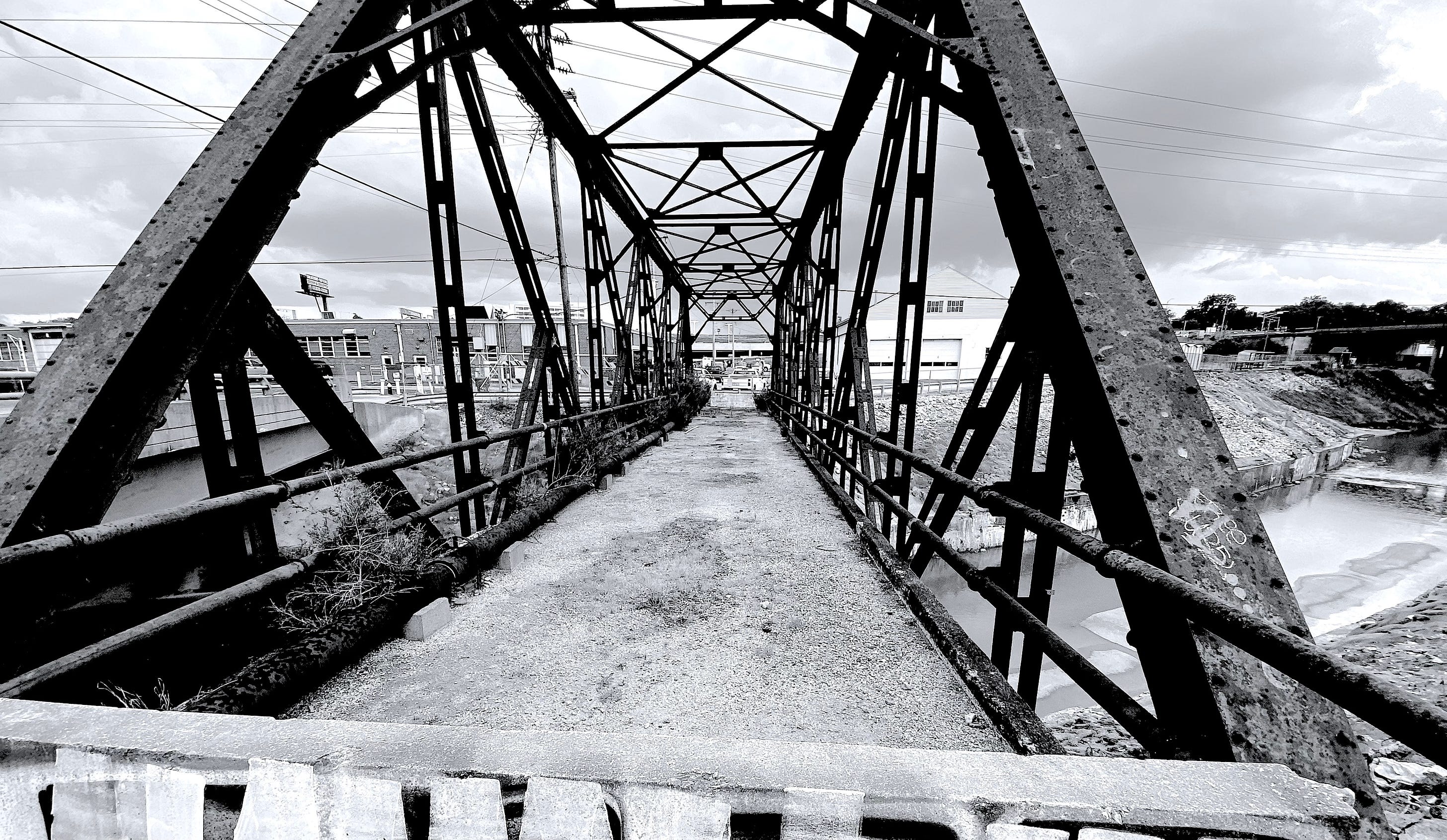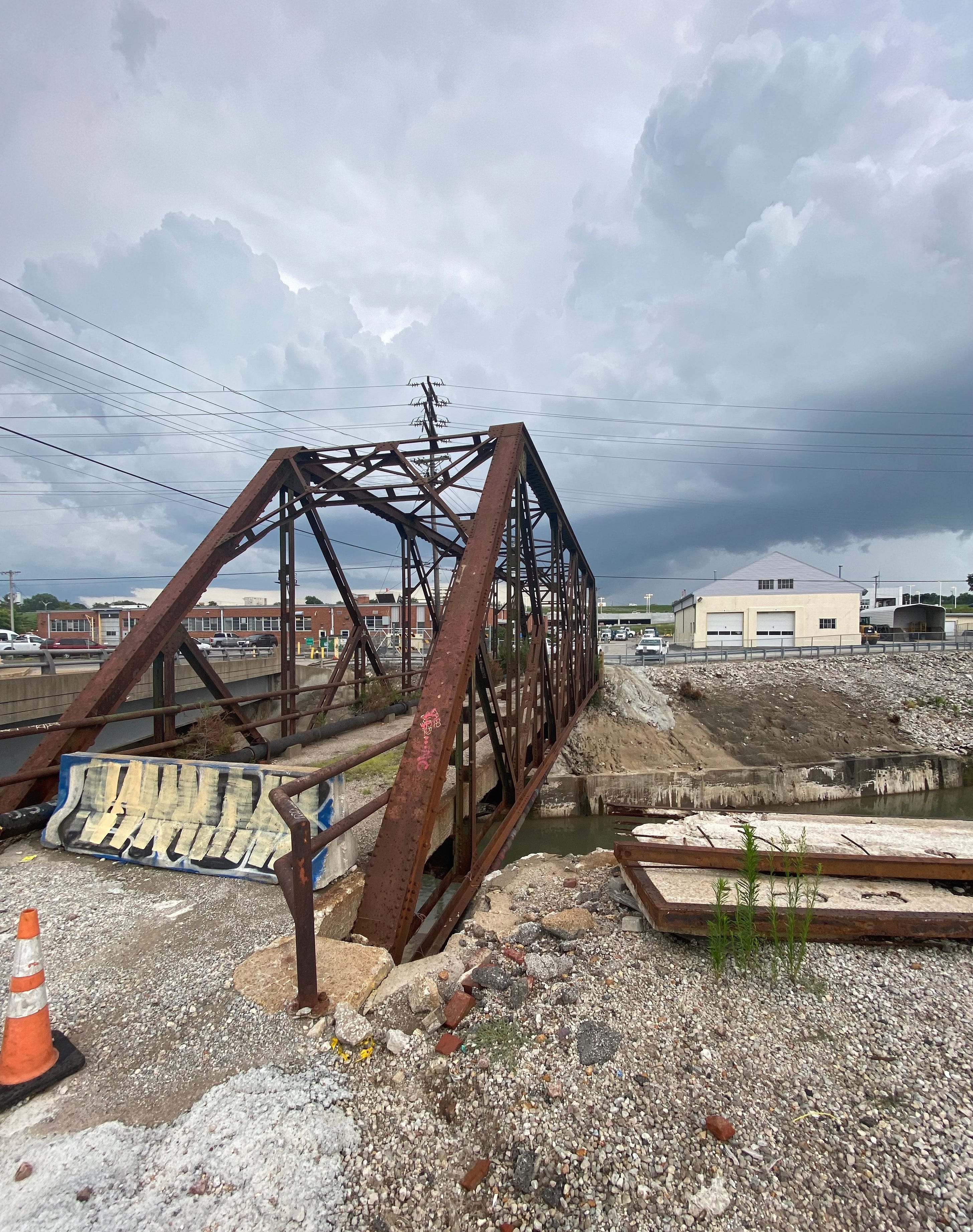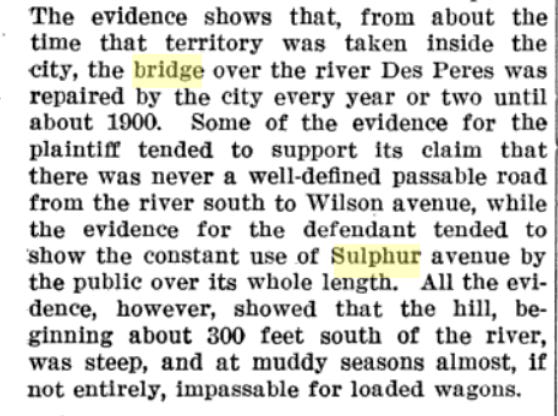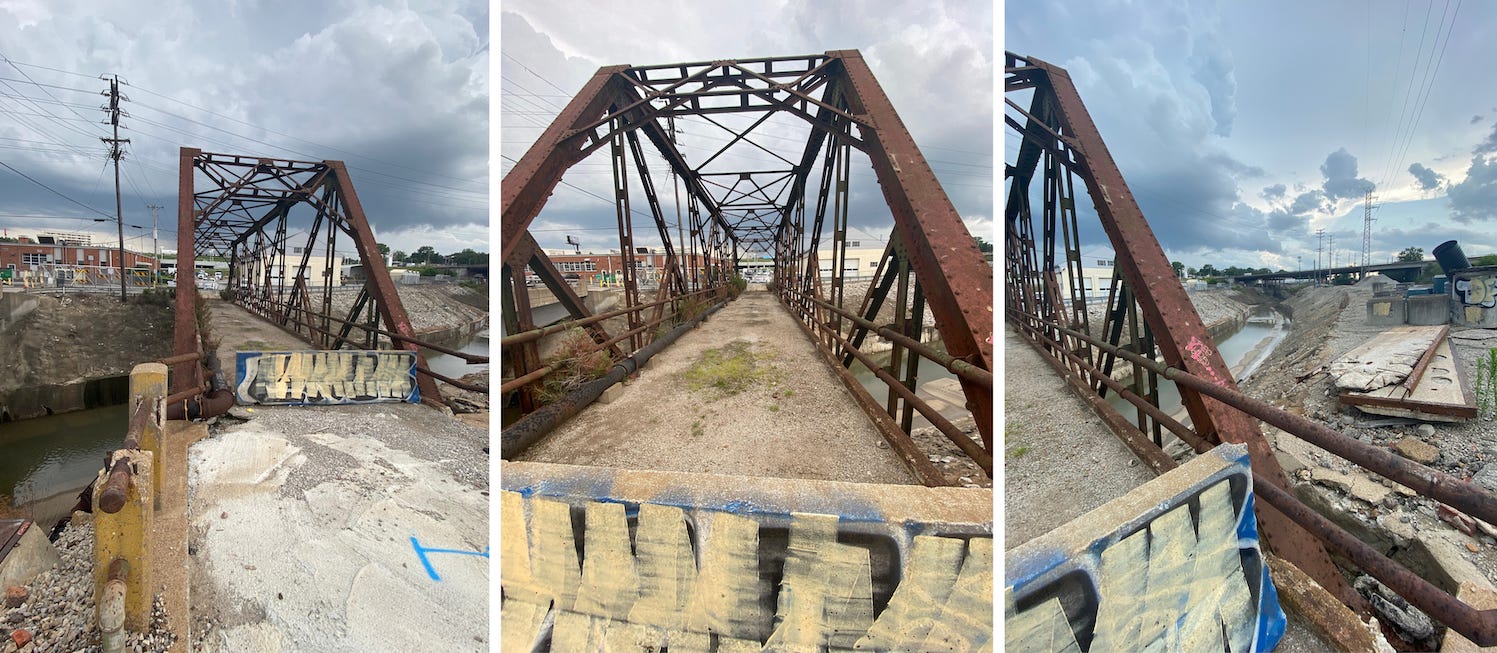Who knows where a rusty bridge might take you
Thanks for reading Story Cauldron, where I investigate what constitutes a story as well as sharing updates about my own writing journey. If you like what you’re reading, considering sharing it with a friend. Who knows where a rusty bridge might take youHow random discoveries can inspire and open doors to all kinds of storiesThis week in Story Cauldron, I’m writing about a bridge—not a famous bridge, not even a functional one. But as it turns out, this random discovery in my hometown has a lot of stories to tell. I randomly discovered this little bridge over the River des Peres in St. Louis on an afternoon outing. It’s nestled snug in the middle of an industrial area of factories and metal recycling that isn’t easily accessed from the main roads. According to Bridgehunter, the Sulphur Avenue bridge is a Baltimore through truss bridge built in 1925. It was decommissioned in 1970 when a more modern bridge was constructed beside it, but it remains in place as a reminder of days gone by. I’ll be the first to admit that it doesn’t look like much at first glance, and I’m sure no one even pays any attention to it. It’s just a rusty old bridge, right? But I love it because I have a thing for truss bridges. They’re one part cage, one part monkey bars, one part ladder to the sky. Even though most of them aren’t that old in the grand scheme of things (this bridge isn’t quite 100 years old) they feel like they are carrying a heavy load of history on their iron shoulders. And in this case, this little bridge led to a whole lot of history. Buckle up, because this ride is about to leave the station! The little bridge and the River des PeresI won’t lie. After I found the bridge a few weeks ago, I became obsessed with it. I wanted to know why it was there and anything else I could find out. Little did I know it would send me on a crazy journey of discovery and inspire the ending of my current novel. The bridge is at the end of Sulphur Street, just off Manchester. The street got its name due to a sulfur spring that bubbled up from the River des Peres (RDP). And that spring helped put the location on the map, so to speak. Combined with the overall beauty of the area, the existence of the spring appealed to the earliest white settlers of the area due to the health benefits of sulfur baths. As the Post-Dispatch noted, the Spanish Governor-General of New Orleans granted the land to fur trader Charles Gratiot in 1798. Gratiot was one of the founding fathers of St. Louis, who married Victoire Chouteau (herself the daughter of explorer Pierre Augustin Laclède), and hosted both Lewis and Clark before their excursion west. At a time when St. Louis was just a small trading post city near the river, Gratiot moved out to the countryside along the River des Peres. He built a home and camp near the location of the modern bridge to take advantage of the health benefits of the springs. Fur trader William Sublette purchased the land in 1831 and built four log cabins there. Eventually, he built a mansion and a resort in what was considered one of the prettiest spots in the entire city. On February 15, 1858, a group of French communalists called the Icarians, having already attempted colonies in Texas and in Nauvoo, Illinois (where they rubbed shoulders with the early Mormons), founded a colony on a few hundred acres along the River des Peres near the springs. However, their efforts didn’t last long, as the colony struggled with internal dissent, and by 1864, only about twenty remained when they abandoned the property. Around that same time, the area where the Sulphur Ave. bridge would later be built became part of a massive brickmaking industry that began after the fire of 1849 that devastated a large area of wooden structures in downtown St. Louis. Because the city was built on top of a rich deposit of red clay, brickmaking sites sprang up all over the city, including at Sulphur Avenue. Other industries, including smelting, also moved into the area. Because of the heavy industry, most of the features that had made the area so attractive to early settlers quickly disappeared. But progress was progress, and in the late 19th century, bricks were hot. Of course, with brickmakers churning out pallets of bricks day after day, it was imperative that there was a reliable way to cross the river. Records indicate that a bridge was built over the river in 1889, undoubtedly replacing simpler bridges, but it continually fell into disrepair. By the early 1900s, complaints about potholes and impassible road conditions reached St. Louis Street Commissioners. Indeed, it appears the old bridge was quite a nuisance: So at some point within the next 25 years, the city finally scrapped the old bridge and built the one that’s there today. I can’t find any reference to its construction (yet!) but I would like to imagine there was a little ribbon-cutting ceremony and speeches from men in top hats. But that doesn’t quite end the story of our little bridge. Indeed, the story wouldn’t be complete without explaining the odd river that it spans. The bridge over the River Des PeresFinding out the history of the Sulphur Ave. bridge opened the door to an even bigger question for me, something that I’ve been curious about since I was a teenager. And that is what’s the deal with the River Des Peres? St. Louis has many rivers: the Mississippi River serves as the city’s and state’s eastern border, while the Missouri River caps the city to the north. To the west and south is the much smaller Meramec, which snakes its way through parts of St. Louis County until it reaches the Mississippi south of the city. All of these rivers are prone to flooding, but for the most part, other than some levees, they are left to do what rivers do. The River Des Peres is different. Unlike the others that are peripheral to the city, RDP runs through the very heart of St. Louis. It starts north of Olive Blvd and meanders through University City, runs through (and under, I discovered!) Forest Park, and then charges through a good chunk of South St. Louis, picking up volume from Deer Creek and other waterways as well as storm runoff, before finding its way to the Mississippi a little south of Carondelet Park. But for pretty much every St. Louisan, it’s an eyesore and a stinky, polluted ditch. Most of the year the river has very little water, and what’s there is filled with trash, chemicals, and other nasty things, such that many in the city refer to it as the “River des Pew.” ‘River des Pew’Up until about the middle of the 19th century, the river was an idyllic stream meandering through the undeveloped countryside. But as the city expanded, the increasing population needed a modern sewer system. Fortunately, there were lots of streams and rivers that crisscrossed the area, and through the end of the century, they did the trick. So the RDP, along with many creeks, helped flush St. Louisans waste downstream into the Mississippi. There were just two problems with that plan (ignoring the environmental concerns, which no one seemed to mind back then).
So you can imagine that well-to-do St. Louisans didn’t want an open sewer stinking up their picnics, but they really didn’t want their homes filled with the excrement of their neighbors. As they say, that shit had to stop. In 1904, the World’s Fair came to Forest Park, and the organizers didn’t want to subject the attendees to the smell of sewage in the part of the RDP that ran through the park, so they enclosed a mile of river in a wooden box. In 1923, after a few devastating floods, the city approved a massive public works project, and over the next decade, the United States Army Corps of Engineers, Horner & Shifrin, and the Works Progress Administration worked to modify the entire river. The stream was either redirected underground in gigantic tunnels or channelized, often with either rock or concrete banks, in an attempt to tame it. The effort was so massive that in 1988, the RDP channel was designated a National Historic Civil Engineering Landmark. And that’s where our bridge comes back into the picture. The River des Peres flows mostly underground from its origins to Macklind Avenue, where two tunnels release it back into the channel just a third of a mile east of the Sulphur Avenue bridge. When my little 1925 bridge was built, the river was undergoing massive changes. I haven’t been able to figure out if the bridge predates the channelization of the river, but given the timing (most of the RDP project didn’t get underway until 1924 and it was two more years before they had been able to start the tunnel south of Forest Park), it seems to me that the bridge must predate the project. If true, means it bears witness to the river as it used to be as well as how it is now. Weaving the bridge into my novelOne of the main reasons I hunted down the bridge in the first place was that I was looking for cool settings for my novel The Boy Who Can Taste Color (which will be available here in October for paid members). In the story, which is set here in St. Louis, the protagonist Holden has gone to the ‘favor faeries,’ magical beings who grant wishes in exchange for snacks and trinkets. He wishes that his annoying stepbrother Travis will move out. When Travis then disappears without a trace, Holden has to find a way to get the faeries to bring him back. Most of the novel had been written when I stumbled across this bridge, but I knew that it would have to figure into the story somewhere. And, as it turns out, the Sulphur Ave. bridge has become part of a pivotal part of the climax of the novel. I also expect that it will continue to feature in future stories as a bridge between our world and that of the faeries. If you’d like to read The Boy Who Can Taste Color when it comes out, be sure to subscribe to the paid version of this newsletter. If you’d like to learn more about the River des Peres, here are some additional fascinating sources:
And allow me to leave you with the River des Peres Song. 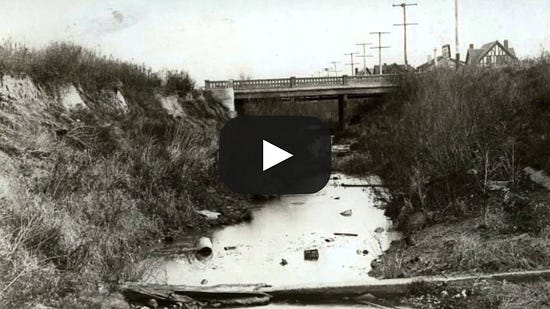 I hope you enjoyed this story about the bridge. Until next time! If you have any feedback for me (including if I have any of the history wrong!) or know of additional sources I can check about the Sulphur Ave. bridge or the River des Peres, please leave a comment! You’re on the free list for Story Cauldron. For the full experience, become a paying subscriber. |
You Might Also Like
Closing Tonight • Black Fri TO CyberMon Book Promos for Authors
Sunday, November 24, 2024
Book Your Spot Now to Get Seen During the Busiest Shopping Season of the Year! "ContentMo is at the top of my promotions list because I always
What it feels like
Sunday, November 24, 2024
Plus, an AI newsletter tool and how to create higher-converting buttons ͏ ͏ ͏ ͏ ͏ ͏ ͏ ͏ ͏ ͏ ͏ ͏ ͏ ͏ ͏ ͏ ͏ ͏ ͏ ͏ ͏ ͏ ͏ ͏ ͏ ͏ ͏ ͏ ͏ ͏ ͏ ͏ ͏ ͏ ͏ ͏ ͏ ͏ ͏ ͏ ͏ ͏ ͏ ͏ ͏ ͏ ͏ ͏ ͏ ͏ ͏ ͏ ͏ ͏ ͏ ͏ ͏ ͏ ͏ ͏ ͏ ͏ ͏ ͏ ͏
🌱UNESCO x Dior mentorship program, Funded internships at UNICEF, Education visa to Netherlands
Sunday, November 24, 2024
The Bloom Issue #192, Nov 24 ͏ ͏ ͏ ͏ ͏ ͏ ͏ ͏ ͏ ͏ ͏ ͏ ͏ ͏ ͏ ͏ ͏ ͏ ͏ ͏ ͏ ͏ ͏ ͏ ͏ ͏ ͏ ͏ ͏ ͏ ͏ ͏ ͏ ͏ ͏ ͏ ͏ ͏ ͏ ͏ ͏ ͏ ͏ ͏ ͏ ͏ ͏ ͏ ͏ ͏ ͏ ͏ ͏ ͏ ͏ ͏ ͏ ͏ ͏ ͏ ͏ ͏ ͏ ͏ ͏ ͏ ͏ ͏ ͏ ͏ ͏ ͏ ͏ ͏ ͏ ͏ ͏ ͏ ͏ ͏ ͏ ͏ ͏ ͏ ͏ ͏
Food for Agile Thought #470: A Short Overview of PM Tools, Product Strategy and Clarity, Bayer’s Bold Bet, Delivering Bad News
Sunday, November 24, 2024
Also: The Brilliant Jerk, POM When Agile Failed? Example Mapping, Discovery Done Right ͏ ͏ ͏ ͏ ͏ ͏ ͏ ͏ ͏ ͏ ͏ ͏ ͏ ͏ ͏ ͏ ͏ ͏ ͏ ͏ ͏ ͏ ͏ ͏ ͏ ͏ ͏ ͏ ͏ ͏ ͏ ͏ ͏ ͏ ͏ ͏ ͏ ͏ ͏ ͏ ͏ ͏ ͏ ͏ ͏ ͏ ͏ ͏ ͏ ͏ ͏ ͏ ͏ ͏ ͏ ͏ ͏
Closes Tomorrow • Black Fri TO CyberMon Book Promos for Authors
Sunday, November 24, 2024
Book Your Spot Now to Get Seen During the Busiest Shopping Season of the Year! "ContentMo is at the top of my promotions list because I always
Kindle & Audiobook : Santa's List: A Short Christmas Story by Riley Blake
Saturday, November 23, 2024
They have big plans for an international killer with an impeccable reputation for always hitting his mark.
Ask your way to product market fit
Saturday, November 23, 2024
Use the Sean Ellis Method and the 40% Test ͏ ͏ ͏ ͏ ͏ ͏ ͏ ͏ ͏ ͏ ͏ ͏ ͏ ͏ ͏ ͏ ͏ ͏ ͏ ͏ ͏ ͏ ͏ ͏ ͏ ͏ ͏ ͏ ͏ ͏ ͏ ͏ ͏ ͏ ͏ ͏ ͏ ͏ ͏ ͏ ͏ ͏ ͏ ͏ ͏ ͏ ͏ ͏ ͏ ͏ ͏ ͏ ͏ ͏ ͏ ͏ ͏ ͏ ͏ ͏ ͏ ͏ ͏ ͏ ͏ ͏ ͏ ͏ ͏ ͏ ͏ ͏ ͏ ͏ ͏ ͏ ͏ ͏ ͏
The end of productivity
Saturday, November 23, 2024
Has AI made this obsolete? ͏ ͏ ͏ ͏ ͏ ͏ ͏ ͏ ͏ ͏ ͏ ͏ ͏ ͏ ͏ ͏ ͏ ͏ ͏ ͏ ͏ ͏ ͏ ͏ ͏ ͏ ͏ ͏ ͏ ͏ ͏ ͏ ͏ ͏ ͏ ͏ ͏ ͏ ͏ ͏ ͏ ͏ ͏ ͏ ͏ ͏ ͏ ͏ ͏ ͏ ͏ ͏ ͏ ͏ ͏ ͏ ͏ ͏ ͏ ͏ ͏ ͏ ͏ ͏ ͏ ͏ ͏ ͏ ͏ ͏ ͏ ͏ ͏ ͏ ͏ ͏ ͏ ͏ ͏ ͏ ͏ ͏ ͏ ͏ ͏ ͏ ͏
Setting Gift-Giving Guidelines for a Minimalist Holiday Season
Saturday, November 23, 2024
Setting Gift-Giving Guidelines for a Minimalist Holiday Season A question I frequently hear from readers aspiring to live a more minimalist holiday season goes like this: “How do you handle holiday
[Electric Speed] Blind spots | Bluesky
Saturday, November 23, 2024
Plus: advent calendars | holiday cards ͏ ͏ ͏ ͏ ͏ ͏ ͏ ͏ ͏ ͏ ͏ ͏ ͏ ͏ ͏ ͏ ͏ ͏ ͏ ͏ ͏ ͏ ͏ ͏ ͏ ͏ ͏ ͏ ͏ ͏ ͏ ͏ ͏ ͏ ͏ ͏ ͏ ͏ ͏ ͏ ͏ ͏ ͏ ͏ ͏ ͏ ͏ ͏ ͏ ͏ ͏ ͏ ͏ ͏ ͏ ͏ ͏ ͏ ͏ ͏ ͏ ͏ ͏ ͏ ͏ ͏ ͏ ͏ ͏ ͏ ͏ ͏ ͏ ͏ ͏ ͏ ͏ ͏ ͏ ͏ ͏

